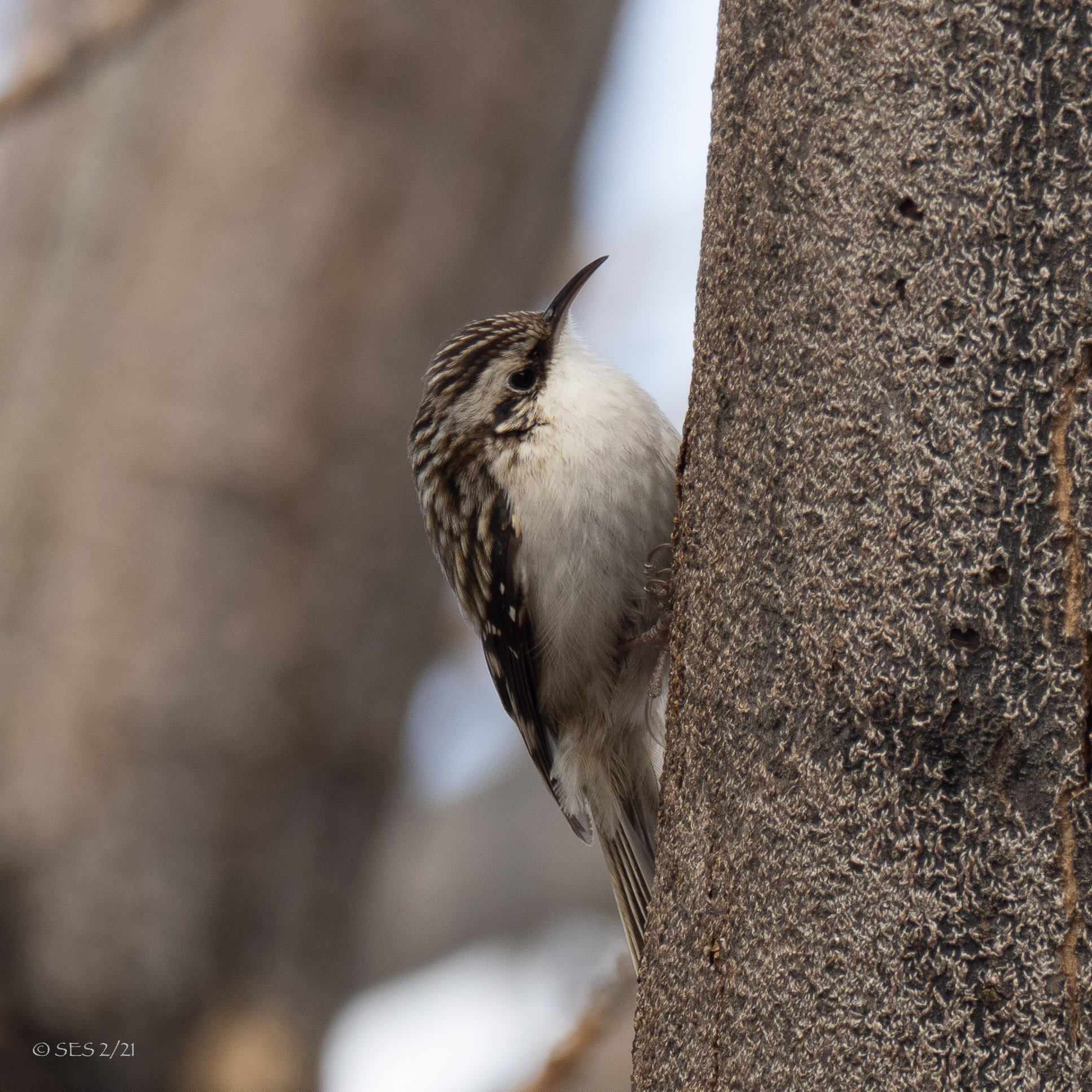January Nature Almanac: It’s a Mouse, It’s a Bird, It’s a BROWN CREEPER!
By Scott Severs, with Ruth Carol Cushman and Stephen R. Jones
January 2024
A crisp breeze carries a wisp of snow in the air and the hint of a pending snowstorm bearing down on the Front Range. The whisper of bird calls carries on the wind as well—the quiet notes of a winter flock searching for sustenance to survive the bitter night ahead. As the flock approaches, it is hard not to notice that several species form the essence of the assemblage.
Brown Creeper’s have a mottled brown back and white underparts with a thin decurved bill that helps find insects in the bark of trees. Photo by Scott Severs.
Chickadees and nuthatches scour the limbs and twigs of a dormant willow searching for spider eggs and other delicacies, and Downy Woodpeckers hammer on the trees searching for insects. Another small bird joins the fray. Darting from tree to tree, it inches up the trunk, pausing occasionally to snap up an insect or to pull apart a cocoon while singing thin, high-pitched seee notes. The herky-jerky climbing actions of this bird makes us think of a little mouse scrambling up a tree. A glance in the field guide confirms its identity as the appropriately named Brown Creeper.
Creepers forage much like nuthatches, investigating the nooks and crannies of the bark of tree trunks. But unlike nuthatches that search for food by running down trees headfirst, creepers spiral up trunks finding prey that nuthatches overlook. Once creepers reach the top of the trunk they fly down to the next tree and start the process over. Creepers possess wonderful adaptations for climbing. Their long sharp claws are ideal for gripping bark, and their stiff tail feathers provide excellent support. In addition, they have decurved bills for reaching insects hiding under bark.
Notice the long toenails (especially on the rear facing toe) and the stiff tail feathers that help the Brown Creeper forage for food on vertical tree trunks. Photo by Scott Severs.
The brown and white feathers of creepers allow them to conceal themselves from predators. The sight of a Sharp-shinned Hawk causes a creeper to flatten out and freeze in its tracks, with its streaked plumage perfectly camouflaged against the bark of the tree. An individual may remain motionless for hours until the danger has passed.
A Brown Creeper frozen motionless and pressed against the tree trunk while a predator flies by. Photo by Scott Severs.
Like many Colorado birds, creepers reside mainly in the mountains during the warm seasons, coming down to the lower woodlands of the Front Range in winter. Old established neighborhoods as well as drainages lined with cottonwoods and willows provide ample foraging areas for flocks of mixed species. The advantage of foraging with other species is threefold. First, birds with better eyesight serve as sentinels, crying out warning notes when a predator appears. Chickadees seem to have a knack for spotting predators such as Sharp-shinned Hawks and American Kestrels. Creepers have excellent close-focus capabilities which allow them to see food in bark crevices, but they may lack the ability to see distant danger. Mixed-species flocks also seem better able to find areas rich in food, so individual birds spend less energy in search of food. Finally, by flocking with other species, individual birds reduce the competition for food with members of their own species. Chickadees, nuthatches, woodpeckers, and creepers forage in slightly different ways and places on trees, each filling a particular niche.
As the winter solstice passes and the days slowly start to lengthen, creepers will occasionally break into beautiful song, described by Roger Tory Peterson as sounding like see-ti-wee-tu-wee. By May, most of the wintering creepers leave the Boulder area, gradually heading for their nesting habitats in mountain forests. Here they perform their song with ceaseless energy.
A bird walk this winter can turn up mixed flocks on Boulder Creek and the lower foothills. This is probably the only time city residents can see the Brown Creeper around our local environs.
Other January Nature Events
Wintering raptor numbers peak on the plains. Search open spaces north of Boulder for hawks, eagles, and falcons.
Fox squirrels begin mating and having litters in tree hollows and leaf nests.
Families of Trumpeter Swans, adults with one or two young, may visit open water where available.



